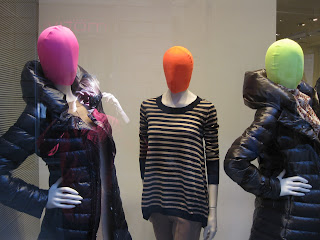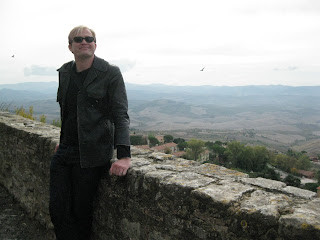…by Italian tourists!?
Ever since I saw a photograph of Gubbio’s Palazzo dei Consoli and its adjacent Piazza Grande, I became obsessed. The palazzo and piazza really stood out to me, given that they are propped up onto the side of a rather steep hill, and both offer dramatic views onto the valley lying below. I’d gone on to read how - similar to Tuscany’s Volterra - Gubbio’s somewhat remote location makes it less of a tourist dumping ground, and its surrounding natural scenery of rocky, forested hills somehow lend it an appealingly somber atmosphere.
So, you can imagine my surprise when our bus arrived in Gubbio today only to get stuck in a mid-town traffic jam, and to then see a steady stream of day-trippers flooding into Gubbio’s main, central entrance. “Gubbio’s been discovered,” I lamented; spoiled - another San Gimigano. And that’s partly why I chose Gubbio over more popular Umbrian hill-towns (like Assisi, Spoleto, Todi, etc.) in the first place – to go somewhere more off the beaten path and avoid the exhausting hordes of day-trippers. And when we went to Volterra, which I thought was much better known than Gubbio, we practically had the town to ourselves! But the interesting thing is that pretty much all the day-trippers in Gubbio today were speaking Italian (more on this point later).
I have to credit Gubbio’s undeniable charms for allowing us to get past all that. Yeah, we were initially dismayed by all the commotion, but it wasn’t difficult to escape the few congested, central arteries, and find more tranquil areas.
The Palazzo dei Consoli was every bit as striking in person as it is in photos. It’s an awesome balance of medieval detail and tasteful restraint, and the setting - with a piazza with one entire edge offering awesome views of the town and valley below - is truly unique. My only complaint (aside from there being hordes of people) was that there weren’t many places on the piazza to sit take in the scenery.
We found in Gubbio some amazing gelato at little place just up the street from Piazza Grande, run by a friendly woman working solo. And wow, her chocolate fondente was so perfect in texture, so rich in flavor, that it was almost like eating a piece of gooey, moist, dense, chocolate cake. Yes, this could rival Siena’s Gelateria Kopa Kobana.
Gubbio’s centro storico is fairly small (smaller than Volterra), so it doesn’t take long to cover one end to the other. After strolling through one of the town’s awe-inspiring main, medieval thoroughfares, we made our way up to the duomo, which is further up the hill, requiring a nearly vertical climb up a narrow, winding lane. Once we got to the duomo and adjacent Palazzo Ducale, we saw this poor guy in a delivery pick-up truck trying to navigate the narrow road that winds around the front of the duomo. He literally had inches on either side of this truck, and passersby were helping him slowly inch his way through the curve. It was kind of miraculous that he managed not to scrape anything.
 |
| A not uncommon sight it Italy |
 |
| View from the Duomo |
After exploring gratuitously picturesque Gubbio from left to right and top to bottom, we checked out the market that’s located under the large buttressing arches that prop up the left side of the Palazzo dei Consoli from the street below. It was mainly truffle-focused, given that the surrounding region is known for its black truffles. Terezia bought some local truffle oil and black truffle pate (which we were able to sample), as well as a bottle of local red wine. It was kind of surreal for a truffle-obsessive like me to see all of these booths with piles of black (and white) truffles on display. It appears to have been a good season!
Overall, we both give Gubbio two thumbs up. It really is a beautiful town, and the setting, wedged along the base of some dramatically steep and rocky hills, makes it that much more attractive. We also realized why there might have been so many Italian tourists there today: it’s the day before All Saints Day, and since that is a national holiday, we think that a lot of people may have both today and tomorrow off (making it a 4-day weekend), and that maybe Gubbio is a popular day-trip destination for Italians in this region. So, perhaps Gubbio isn’t quite so crazy on a normal day? I’d love to revisit Gubbio during a time when it is a bit less cuckoo.
After a totally crazy bus ride back to Perugia (which, like the ride to Volterra, took us through some nauseatingly winding roads that left Terezia’s stomach a little unsettled), we tried a restaurant called La Lanterna, which was recommended by a few travel guides. The ambience was a huge improvement over the previous night’s blend of medieval dungeon décor and 80s dancehall music, and the food was pretty good (but still nothing mind-blowing – I’m beginning to wonder if Perugia is just a crappy place for food). For antipasti, we had liver pate crostini, a salad with radicchio, shavings of cheese, and black truffle pate, both of which were tasty. We decided to take a break from pasta and ordered two secondi: a veal with a black truffle sauce and shavings, and this thing called lombetto crosto con crema di porcini e tartufo, which was basically very tender pork that had been baked in dough, then sliced and slathered in a comforting, rich sauce. Surprisingly, the veal from the previous night’s place was a little better (creamier, juicier), and while the lombetto was definitely tasty, the porcini and truffle flavors really didn’t come through. On the whole it seemed like better-presented and better-prepared food than the previous two nights, but still no life-altering experience. I’m starting to give up hope of ever finding a truly fabulous meal here in Perugia.
Click here to see all of the Gubbio photos!




















































